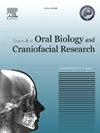Propolis nanoemulsion extract from celebes stingless bee (Tetragonula biroi) phytochemistry and antibacterial analysis to periodontopathogen bacteria
Q1 Medicine
Journal of oral biology and craniofacial research
Pub Date : 2025-03-28
DOI:10.1016/j.jobcr.2025.03.013
引用次数: 0
Abstract
Background
Propolis from Sulawesi's stingless bees (Tetragonula biroi) contains antioxidants, more flavonoids than propolis from Apis bees, and the antibacterial ability.
Objective
to examine the antibacterial properties of Propolis Nanoemulsion Extract (PNE), which is extracted from the Celebes Stingless Bee (T. biroi), in relation to the periodontopathogen bacteria such as Fusobacterium nucleatum (Fn), Porphyromonas gingivalis (Pg), Aggregatibacter actinomycetemcomitans (Aa), and Provotella intermedia (Pi). This investigation also examines PNE's phytochemistry, particle size analysis (PSA), and zeta potential.
Methods
The maceration process with 96 % ethanol was used to create PNE from Celebes stingless bee (T. biroi), which was then subjected to zeta potential measurement and PSA. Phytochemical analysis was used to identify phytochemical constituents in the PNE (T. biroi). Diffusion zone, minimum bactericidal concentration (MBC), and minimum inhibitory concentration (MIC) were used to assess antibacterial efficacy against Aa, Pg, Pi, and Fn. Furthermore, the statistical analysis was used to extract the data.
Results
Phenols, alkaloids, and flavonoids were identified; however, triterpenoids and saponins were not. Between 151.28 and 182.2 diameter nanometers (d.nm) was the range of the PNE's diameter. At 1.56 % propolis (T. biroi) concentration, the MIC, MBC, and diffusion zone analysis performed better than at 0.76 %, with a significant difference (p:0.01; p < 0.05) to Aa, Pg, Pi, and Fn.
Conclusions
The highest antibacterial activity against Aa, Pg, Pi, and Fn as periodontopathogen bacteria is demonstrated by alkaloids, flavonoids, and phenols in PNE from Celebes (T. biroi) at a concentration of 1.56 %.

无刺蜂蜂胶纳米乳提取物的植物化学及对牙周病致病菌的抑菌分析
苏拉威西无刺蜂(Tetragonula biroi)的蜂胶含有抗氧化剂,黄酮类化合物含量高于美国蜜蜂蜂胶,具有抗菌能力。目的研究从无刺蜜蜂(T. biroi)中提取的蜂胶纳米乳提取物(PNE)对牙周病致病菌如核梭杆菌(Fn)、牙龈卟啉单胞菌(Pg)、放线菌聚集菌(Aa)和中间芽胞菌(Pi)的抑菌作用。这项调查还检查了PNE的植物化学,粒度分析(PSA)和zeta电位。方法采用96%乙醇浸渍法制备无刺蜜蜂PNE,并对其进行zeta电位测定和PSA测定。采用植物化学分析方法鉴定了PNE (T. biroi)中的植物化学成分。采用扩散区、最小杀菌浓度(MBC)和最小抑菌浓度(MIC)评价其对Aa、Pg、Pi和Fn的抑菌效果。进一步,采用统计分析方法提取数据。结果鉴定出酚类、生物碱类和黄酮类化合物;然而,三萜和皂苷却没有。PNE的直径范围为151.28 ~ 182.2直径纳米(d.nm)。蜂胶浓度为1.56%时,MIC、MBC和扩散区分析效果优于浓度为0.76%时,差异有统计学意义(p:0.01;p & lt;0.05)到Aa、Pg、Pi和Fn。结论对牙周病致病菌Aa、Pg、Pi、Fn的抑菌活性以浓度为1.56%的黄酮类、酚类生物碱最强。
本文章由计算机程序翻译,如有差异,请以英文原文为准。
求助全文
约1分钟内获得全文
求助全文
来源期刊

Journal of oral biology and craniofacial research
Medicine-Otorhinolaryngology
CiteScore
4.90
自引率
0.00%
发文量
133
审稿时长
167 days
期刊介绍:
Journal of Oral Biology and Craniofacial Research (JOBCR)is the official journal of the Craniofacial Research Foundation (CRF). The journal aims to provide a common platform for both clinical and translational research and to promote interdisciplinary sciences in craniofacial region. JOBCR publishes content that includes diseases, injuries and defects in the head, neck, face, jaws and the hard and soft tissues of the mouth and jaws and face region; diagnosis and medical management of diseases specific to the orofacial tissues and of oral manifestations of systemic diseases; studies on identifying populations at risk of oral disease or in need of specific care, and comparing regional, environmental, social, and access similarities and differences in dental care between populations; diseases of the mouth and related structures like salivary glands, temporomandibular joints, facial muscles and perioral skin; biomedical engineering, tissue engineering and stem cells. The journal publishes reviews, commentaries, peer-reviewed original research articles, short communication, and case reports.
 求助内容:
求助内容: 应助结果提醒方式:
应助结果提醒方式:


